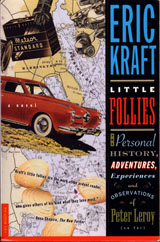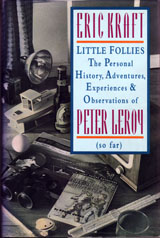
YOU CAN READ THE FIRST HALF
OF THE BOOK HERE,
ONLINE, ONSCREEN.
YOU CAN ORDER THE
PICADOR USA EDITION
AT
AMAZON.COM
OR
BARNES&NOBLE.COM |
|
| The Clam Fest, of course, includes a Queen, an adolescent who is made
to wear an abbreviated costume and ride, at the head of a procession of
clamboats, on the boat belonging to the oldest of the clamdiggers, in the
bow, as far forward as possible, with her legs dangling overboard.
Since the oldest clamboats were once sailing vessels, she is likely to
be straddling a bowsprit, in a display that is really too much for words.
Boating on the Bolotomy
|
 ASKOL
AND I waited beyond the Municipal Dock, on the bay side, away from the
crowds on the river side, and there we went unnoticed. After an hour
or so, we heard a murmur rise from the crowd, and soon we could hear, over
the murmurs of the crowd, the Babbington High School Band, playing the
Bergomask from Ottorino Respighi’s Ancient Airs and Dances for the Lute,
scored
for marching band by Babbington High’s own Timothy J. Courtney, a prodigy
of some note. ASKOL
AND I waited beyond the Municipal Dock, on the bay side, away from the
crowds on the river side, and there we went unnoticed. After an hour
or so, we heard a murmur rise from the crowd, and soon we could hear, over
the murmurs of the crowd, the Babbington High School Band, playing the
Bergomask from Ottorino Respighi’s Ancient Airs and Dances for the Lute,
scored
for marching band by Babbington High’s own Timothy J. Courtney, a prodigy
of some note.
“That’s our cue,” I said. We pushed off.
I saw, approaching us, the Agnes My Dear, the oldest clamboat on
the bay. In the bow, straddling the bowsprit, was a girl with yellow
hair, shining in the sun. She was waving and smiling, and I was certain
that much of her waving and smiling was for me. I thought that I
could see in her smile a little dreamy admiration for a fellow as young
as I was who had such pluck. I waved and smiled back at her.
Arranged along the deck were other girls, also waving and smiling.
Behind the boat full of girls was a barge, on which the band was standing,
playing away and performing some drill routines. People were lined
up along the banks, many holding cameras. In some places I could
pick out whole families, sitting on folding chairs, with bright umbrellas
stuck in the ground beside them. Small children were waving tiny
flags. Here and there were girls my age, in ruffled dresses, throwing
flowers into the river, and boys my age, awestruck and envious, throwing
stones into the river and being cuffed by their parents.
After the barge came the clamboats, decked out with
flowers and banners. The mayor stood on one, and Raskol and I saluted
him as our boats passed each other. He called out “Good luck, boys,”
or something similar, as we passed. A motorboat full of news photographers
wound in and out of the procession.
The band was charging into the grand, swelling,
soaring conclusion to the Bergomask. Raskol and I had nearly reached
Leech’s Son’s Boatyard, and the end of the beginning of the journey.
I was ecstatic. I had been elevated by the music and the crowd.
I stood in the boat and waved my paddle to them all. In my enthusiasm,
I waved a little too wildly, and for a moment I could imagine myself falling
into the water as I had in “Do Clams Bite?” It would be, I thought
as I struggled to keep my balance, my luck to have the photographers come
cruising by, with most of the formal procession past now and only the least
attractive clamboats still to reach the dock, looking for some human interest
shots, something like a couple of boys in a homemade boat, and capture
this moment with their expensive cameras. In the photograph I would
be half in the water, my right half hidden below the surface, my left arm
and leg flailing, my mouth and eyes wide, my paddle in the air above me,
Raskol hiding his head in his hands.
But I recovered, and by shifting my weight and using
my paddle as a counterweight I kept myself upright, and I let myself down
carefully into the boat again. My ears were burning. I bent
to the work of paddling the boat, and looked straight ahead, upriver, until
we were past the boatyard and out of sight of everyone.
I cleared my throat. “Do you think anybody noticed?”
I asked Raskol.
He burst out laughing. “Probably,” he said.
I could feel the blood rise to my face, and I could
imagine the headline in the Babbington Reporter:
Clam Fest Almost Marred by Near-Tragedy
Boy Nearly Falls from Crude Boat
We paddled the boat under the bridge, and left the
music and the crowds behind us. My embarrassment passed, and my heart
swelled with excitement and pride. Ahead of us lay a pond, nearly
circular, with cattails around the edge. This pond was the end of
the estuarial stretch of the river, the Bay’s farthest penetration into
the land. The pond caught the fresh river water flowing downward
and the bay water flowing in with the tide.
“There’s a nice spot, over there,” said Raskol.
I turned back toward him, and he pointed out a sandy
spot on the shore, a break in the cattails.
“That is a nice spot,” I said. I was gushing
with excitement and enthusiasm. I would have agreed with anything.
Raskol began heading us toward the sandy spot.
“What are you doing?” I asked.
“I’m heading us over there,” he said, “toward that
nice spot.”
“Why?” I asked.
“So we can eat our lunch,” he said, a note of surprise
in his voice.
“Eat our lunch?” I cried. “We just got started.
It’s only about nine in the morning.”
Raskol was silent for a while, but he stopped paddling.
“Did you eat breakfast?” he asked at last, and this time there was a note
of concern in his voice.
“No,” I said. “I was too excited to eat, and
I had to get over to your house early, remember?”
“Hey, you must be starving,” he said. “It’s
not a good idea to start a journey like this on an empty stomach.
You got anything packed for breakfast?”
“Not for today’s breakfast,” I said, frowning.
I could see what was going to happen. “Just tomorrow and the next
day.”
“Hmmm,” he said, his brows knit. He looked
the way Gumma did when she was about to tell me that I was looking a little
peaked. “We’d better get something to eat. We’ve got a lot of work
ahead of us. Tell you what. Why don’t we beach the boat over
there and walk into town and get something at the diner?”
I sighed, but I didn’t argue. We paddled the
boat to shore, hid it in the cattails, and walked downtown to the Babbington
Diner, where Raskol had fried eggs, home fries, bacon, toast, and coffee.
I had a doughnut and a glass of milk. |
|
 |




